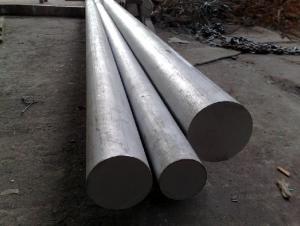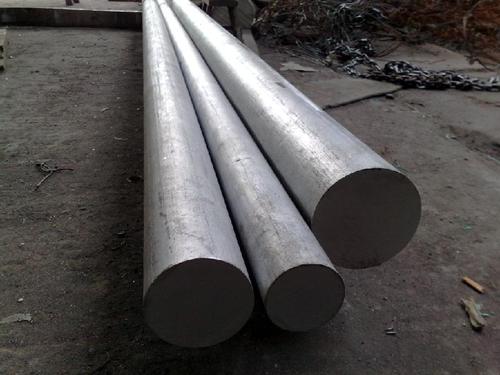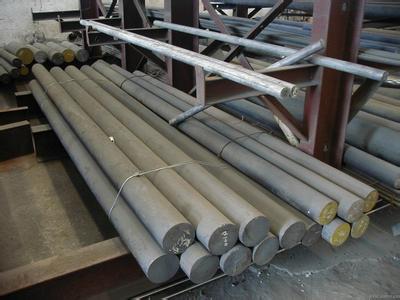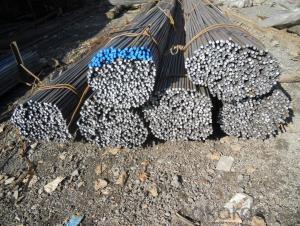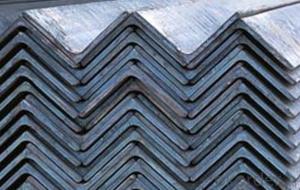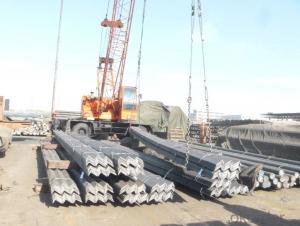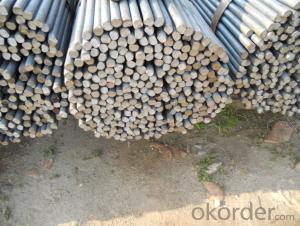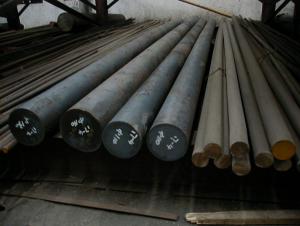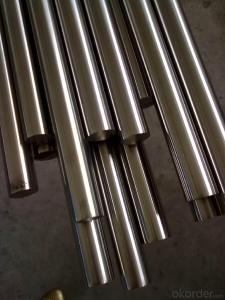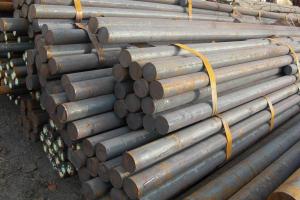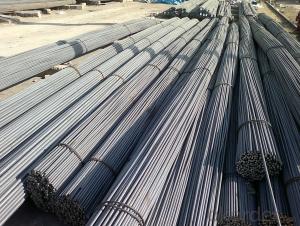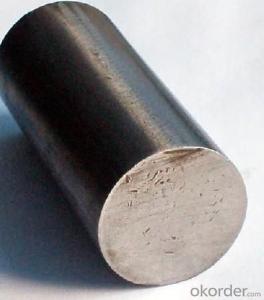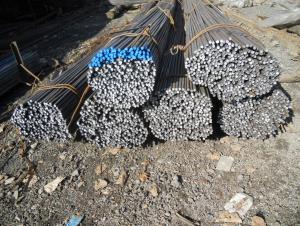High grade hot rolled round steel
- Loading Port:
- China Main Port
- Payment Terms:
- TT OR LC
- Min Order Qty:
- -
- Supply Capability:
- -
OKorder Service Pledge
OKorder Financial Service
You Might Also Like
Round steel refers to the solid section for circular strip steel. Its specifications expressed as a number of mm in diameter, such as "50" indicates that the diameter of 50 mm round steel.
The material of round steel, Q195, Q235, 10 #, 20 #, 35 #, 45 #, Q215, Q235, 304, 316, 40 cr, cr, 20 crmo, 35 crmo, 42 crmo, 40 crnimo, GCr15, 65 mn, 50 mn, cr, 3 cr2w8v, 20 crmnti, 5 crmnmo, etc.
Round steel hot rolling, forging and cold drawn three kinds. The specifications of the hot rolled round steel of 5.5 to 250 mm. Among them: 5.5-25 mm small round steel are mostly with straight bundles of supplies, commonly used for reinforcing steel bar, bolt, and various mechanical parts; More than 25 mm round steel, mainly used in the manufacture of machinery parts and seamless steel tube. The difference between the round steel and other steel: 1 appearance is not the same, round steel exterior circle of light, no lines without ribs, and other steel surface appearance has a groove or a rib, thus causing the cohesive force of small round steel and concrete, and the other the cohesive force of steel bar and reinforced concrete. 2 ingredients are different, round steel (level 1) steel belong to the normal low carbon steel, more than other reinforcement for alloy steel. Three different intensity, low intensity of round steel and other steel with high intensity, the diameter of the same size of round steel compared with other steel bar, round steel can withstand strength than other bar is small, but the plastic is better than other steel round steel, the round steel before is pulled with large deformation, and other steel before be pulled deformation is much smaller.
classification
The editor
1. According to the chemical classification
Carbon steel according to the chemical composition (i.e., with carbon content) can be divided into low carbon steel, medium carbon steel and high carbon steel.
(1) low carbon steel
Also known as mild steel, carbon content from 0.10% to 0.30% of low carbon steel is easy to accept all kinds of processing such as forging, welding and cutting, often used in the production chain, rivet, bolts, shaft, etc.
(2) the medium carbon steel
Carbon is 0.25% ~ 0.60% of the carbon steel. Have a calming, half killed steel, steel and other steel products. In addition to the carbon can also contain a small amount of manganese (0.70% ~ 1.20%). According to the quality of the products are divided into ordinary carbon structural steel and high quality carbon structural steel. Hot working and cutting performance is good, poor welding performance. Strength and hardness is higher than low carbon steel and the plasticity and toughness lower than that of low carbon steel. Without heat treatment, direct use of hot rolled, cold drawn material, can be used after heat treatment. The medium carbon steel after quenching and tempering has good comprehensive mechanical properties. To achieve the highest hardness about HRC55 (HB538), sigma b for 600 ~ 600 mpa. So in a moderate level of a variety of purposes, medium carbon steel is the most widely used, except as building materials, also used in the manufacture of various kinds of machinery parts.
(3) the high carbon steel
Often called tool steel, carbon content from 0.60% to 1.70%, can be hardening and tempering. Hammer, crowbar, etc by the carbon content of 0.75% steel manufacturing; Cutting tools such as drill, tap, reamer, etc by between 0.90% and 1.00% of the carbon content of steel manufacturing.
2. According to the quality of the steel
According to the quality of the steel can be divided into ordinary carbon steel and high quality carbon steel.
(1) ordinary carbon structural steel, also known as ordinary carbon steel, the carbon content, performance range, and phosphorus, sulfur and other residual elements content is relatively wide. In China and some countries according to the guarantee of delivery condition is divided into three categories: class A steel steel (class A) is to ensure that the mechanical properties of steel. B steel steel (class B) is the guarantee of the chemical composition of the steel. Special type of steel (class C) steel is both ensure the mechanical properties and guarantee the chemical composition of steel, often used in the manufacture of the important structures. China is now the production and use of the most is around 0.20% of A3 carbon steel (steel) a class 3, mainly used in engineering structure.
Some carbon structural steel and adding trace amounts of aluminum or niobium (or other) carbide forming elements to form nitrides or carbide particles, to limit the grain growth, make the steel reinforcement, save steel. In China and some countries, in order to adapt to the special requirements of professional steel, the chemical composition and properties of ordinary carbon structural steel, so as to develop a series of ordinary carbon structural steel major steel, such as Bridges, buildings, pressure vessel steel, steel, etc.).
(2) high quality carbon structural steel and ordinary carbon structural steel, sulfur, phosphorus and other non-metallic inclusion content is low. According to carbon content and purpose is different, this kind of steel is roughly divided into three categories: (1) is less than 0.25% C for low carbon steel, notably the carbon less than 0.10% of the 08 f, 08 al and so on, because has the very good deep-drawing property and weldability and is widely used for deep drawing parts such as automobile, can... And so on. The main material of 20 g is making ordinary boiler. In addition, low carbon steel as carburizing steel, widely used in mechanical manufacturing industry. (2) 0.25 ~ 0.60% C for medium carbon steel, used in the quenched and tempered state more, make parts of machinery manufacturing industry. (3) greater than 0.6% C for high carbon steel, used in the manufacture of springs, gears, roll, etc. According to different manganese content, and can be divided into ordinary manganese content (0.25 ~ 0.8%) and high manganese content (0.7 ~ 1.0% and 0.9 ~ 1.2%) steel group. Manganese can improve the hardenability of steel, strengthen the ferrite, improve the steel yield strength, tensile strength and abrasion resistance. Usually in the high manganese steel grades after additional tags "Mn", such as 15 Mn, 20 Mn to distinguish it from normal carbon steel containing manganese content.
3. According to the classification purpose
According to the purposes and can be divided into carbon structural steel, carbon tool steel.
Carbon tool steel carbon content between 0.65 ~ 1.35%, high hardness and high wear resistance can be obtained after heat treatment, mainly used in the manufacture of various tools and cutters, mould and measuring tool (see tool steel).
Carbon structural steel in accordance with the steel yield strength is divided into five grades:
Q195, Q215, Q235, Q255, Q275
Each brand due to different quality is divided into A, B, C, D level, there are four most, some only one; In addition, a steel smelting deoxidizing method.
Deoxidizing method symbols:
F - rimmed steel
B - half killed steel
Z - killed steel
TZ - special killed steel
- Q: Are steel round bars recyclable?
- Indeed, recyclability is a characteristic inherent to steel round bars. Steel, being of immense value and easily recyclable, is among the most frequently recycled materials worldwide. Once steel round bars have served their purpose, they may be gathered and dispatched to a recycling facility. Within this facility, the round bars are subjected to the melting process, resulting in their conversion into novel steel products. Remarkably, this cycle can be perpetually repeated without any detrimental impact on the steel's quality. By choosing to recycle steel round bars, not only do we aid in the preservation of natural resources and the reduction of waste, but we also contribute to energy conservation and the mitigation of greenhouse gas emissions as opposed to the production of steel from raw materials.
- Q: What is the difference between a circle and round steel continuous casting
- The first two density is not the same, the round billet continuous casting billet is molten steel into round billet crystallizer, after two cold water cooling, solidification formation, density is small; bar is formed by the billet or round billet rolled steel products, good density, better mechanical properties than the same size of billet. Second, round billet is the raw material for steel rolling, and the bar is the final product sold as steel.
- Q: What is the difference between a smooth and a deformed steel round bar?
- A smooth steel round bar refers to a bar that has a consistently even surface without any visible imperfections or deformities. It is typically manufactured through a process called hot rolling, where a steel billet is heated and passed through a series of rolling mills to achieve the desired shape and surface finish. Smooth steel round bars are commonly used in applications where aesthetics and surface quality are important, such as architectural designs or decorative metalwork. On the other hand, a deformed steel round bar has intentional deformations or patterns on its surface. These deformations can take various forms, including ridges, ribs, or indentations. The purpose of adding deformations to the surface of a steel round bar is to enhance its bonding ability with concrete or other materials. The irregular surface of a deformed bar provides increased friction and better adhesion, improving the structural integrity of reinforced concrete structures. Deformed steel round bars are primarily used in construction projects, particularly in reinforced concrete structures like columns, beams, and slabs. The deformations on the surface of the bar help to prevent slippage between the steel and concrete, ensuring a stronger bond and improving the overall stability and durability of the structure. In summary, the main difference between a smooth and a deformed steel round bar lies in their surface characteristics and intended applications. Smooth bars have a uniform and smooth surface, ideal for applications where aesthetics and surface quality are important. Deformed bars, on the other hand, have intentional deformations to enhance bonding with concrete, making them suitable for construction projects requiring reinforced concrete structures.
- Q: What are the different types of steel used in manufacturing round bars?
- Round bars in manufacturing can be made from various types of steel. The most commonly used types include: 1. Carbon Steel: This is the go-to steel for manufacturing round bars due to its strength and durability. It mainly consists of iron and carbon and finds application in construction, automotive, and machinery. 2. Alloy Steel: By adding elements like manganese, nickel, chromium, and molybdenum to carbon steel, alloy steel is formed. This enhances its strength and hardness, making it suitable for applications that demand high strength and resistance to wear and tear. 3. Stainless Steel: A type of alloy steel, stainless steel contains a minimum of 10.5% chromium. This high chromium content gives it excellent corrosion resistance, making it ideal for applications exposed to moisture or chemicals. Stainless steel round bars are commonly used in kitchen utensils, medical equipment, and automotive parts manufacturing. 4. Tool Steel: Tool steel is an alloy steel designed specifically for high hardness, wear resistance, and heat resistance. It is commonly used in manufacturing cutting tools, dies, and molds. Tool steel round bars are usually made from high-carbon steel with additional elements like tungsten, vanadium, or cobalt. 5. Bearing Steel: Bearing steel is an alloy steel specifically formulated for bearing applications. It is characterized by its high hardness, wear resistance, and fatigue strength. Bearing steel round bars are widely used in bearing manufacturing for industries like automotive, aerospace, and industrial machinery. These examples demonstrate the range of steel types available for manufacturing round bars. The specific choice of steel depends on the desired properties and requirements of the application at hand.
- Q: Can steel round bars be used as axles or shafts?
- Yes, steel round bars can be used as axles or shafts due to their high strength, durability, and ability to withstand heavy loads and torque. They are commonly used in various industries such as automotive, marine, and construction for their excellent mechanical properties and reliability.
- Q: Can steel round bars be used for making marine equipment?
- Yes, steel round bars can be used for making marine equipment. Steel is a durable and corrosion-resistant material that is commonly used in the marine industry for various applications such as shipbuilding, offshore structures, and marine equipment. However, it is important to ensure that the steel used is specifically designed for marine environments to prevent corrosion and maintain the integrity of the equipment.
- Q: What are the different types of steel used for round bars?
- There are several different types of steel used for round bars, including carbon steel, alloy steel, stainless steel, and tool steel. Each type has its own unique composition and properties, making them suitable for various applications and industries.
- Q: Can steel round bars be used for making architectural or decorative elements?
- Yes, steel round bars can be used for making architectural or decorative elements. They are versatile and can be shaped, welded, and fabricated into various designs, giving them the potential to enhance the aesthetic appeal of architectural structures or serve as decorative elements.
- Q: Are steel round bars suitable for the production of hydraulic cylinders?
- Yes, steel round bars are suitable for the production of hydraulic cylinders. Steel round bars provide excellent strength, durability, and resistance to wear and tear, making them a reliable choice for hydraulic cylinder production. Additionally, their versatility allows for customization and various configurations to meet specific hydraulic system requirements.
- Q: What are the different heat treatment processes used for steel round bars?
- Some of the different heat treatment processes used for steel round bars include annealing, quenching, tempering, normalizing, and hardening. Each process involves heating and cooling the steel to alter its properties such as hardness, strength, and ductility. Annealing involves heating the steel and slowly cooling it to relieve internal stresses and improve machinability. Quenching involves rapidly cooling the steel to increase its hardness. Tempering is a process that involves reheating the quenched steel to reduce brittleness and improve toughness. Normalizing is similar to annealing but involves air cooling instead of slow cooling. Hardening is a process that involves heating the steel and then rapidly cooling it to increase its hardness and strength.
Send your message to us
High grade hot rolled round steel
- Loading Port:
- China Main Port
- Payment Terms:
- TT OR LC
- Min Order Qty:
- -
- Supply Capability:
- -
OKorder Service Pledge
OKorder Financial Service
Similar products
Hot products
Hot Searches
Related keywords
